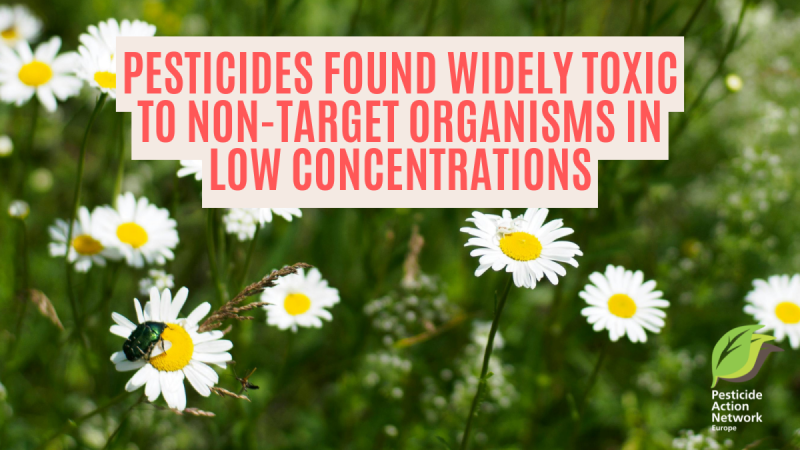A 2025 meta-analysis of 1,705 studies confirms that pesticides are widely toxic to many non-target organisms. “Pesticides affect a diverse range of non-target species and may be linked to global biodiversity loss. The magnitude of this hazard remains only partially understood.” The authors conclude: “Our results question the sustainability of current pesticide use and support the need for enhanced risk assessments to reduce risks to biodiversity and ecosystems.”
Several tonnes of pesticides are applied worldwide each year. This industrial model of agriculture relies on massive pesticide use and poses a serious threat to pollinators and other insects we depend on. The study Pesticides have negative effects on non-target organisms is based on 1,705 studies in a broad variety of landscapes. It shows a very concerning reality: pesticides should not only be assessed looking at lethal doses. They harm many species already in low concentrations by reducing growth and reproduction, altering behaviour, and disrupting basic functions. These effects can worsen when different chemicals combine or persist in the environment. [1]
Spraying pesticides at landscape scale
“If you spray the landscape with insect poison, you should not really be surprised if insects decline. It is kind of almost inevitable, however carefully you do it,” said Biology professor Dave Goulson, one of the authors of this paper, in an interview with PAN Europe.
Insects and other arthropod populations are rapidly declining. There are several causes, such as habitat loss, climate change, and light pollution, but probably the biggest driver is the modern farming model, more mechanised and reliant on massive use of pesticides. “It is hard to say exactly what proportion of insect declines can be attributed to pesticides because insecticide use is wrapped up in a whole system of farming, and almost every aspect of that is harmful to insect life,” Goulson pointed out.
According to the study, negative pesticide impacts are stronger in temperate regions but occur worldwide. Even when substances are designed for specific pests, they often harm other species, such as neonicotinoids affecting amphibians and humans. Examples include fungicides reducing beneficial fungi, herbicides harming plant metabolism and pollen viability, and insecticides contributing to pollinator declines. However, pesticide risk assessment, focused on a limited number of model species, such as rats, is unlikely to capture the variety of responses to pesticide exposure seen across the diversity of species.
“The regulatory system for pesticides has just repeatedly let us down. It has failed to detect pesticides, which turned out to have environmental impacts when they were used by farmers at a landscape scale. There are lots of examples,” said Goulson.
The hidden costs of pesticides
Although it is frequently argued by the supporters of intensive agriculture that pesticides are beneficial for financial reasons, this paper indicates that the low cost of pesticides fails to account for hidden costs to wildlife and ecosystems. This makes sustainable practices less attractive financially for farmers, who might keep using pesticides as a preventative measure.
Additionally, there are limitations of regulatory assessments in predicting real-world hazards like long-term low-level exposure, cumulative effects at landscape level, or interactions between active ingredients.
“The system looks at short-term exposure, usually one dose of pesticide when we know that non-target insects are continually exposed to pesticides probably all of their life at varying doses. [...] Insects are exposed to cocktails of chemicals which are not evaluated and we know that sometimes those chemicals can act synergistically. So the effects are not additive, the presence of one pesticide can greatly exacerbate the toxicity of another pesticide. That is all completely ignored by the regulatory system,” Goulson highlighted.
Conclusion: we need a better regulatory system
The massive use of pesticides reached 4.1 million tons of active ingredients applied worldwide in 2015. Due to its impacts on biodiversity, an agricultural system that is heavily reliant on pesticides is an unsustainable model.
Instead, the paper advocates for widespread policy measures to reduce pesticides. Integrated Pest Management (IPM) programmes, which prioritise non-chemical control methods, and optimising threshold-based decisions. Without such measures, unexpected and long-term impacts on biodiversity and ecosystem functioning will remain “unacceptably high,” according to the authors of this paper.
“A better regulatory system means it will cost more money to bring a new pesticide to market. And the pesticide industry tried to claim that we would not have any new pesticides if we had a more rigorous regulatory system. I have to say I just do not believe that. We have a lot of pesticides on the market at present, in Europe alone about 500 different pesticides. We are not short of pesticides. But we are short of insects and biodiversity,” Goulson concluded.
Read more:
- Pesticides threaten the bulk of life on Earth - Interview with Prof. Dave Goulson
- Restore biodiversity - protect bees and bugs
Notes:
[1] Pesticides have negative effects on non-target organisms
